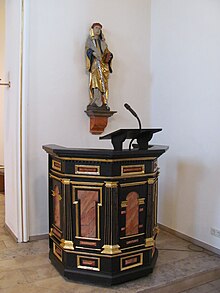Gotthard of Hildesheim
Saint Gotthard | |
|---|---|
Rheims by Pope Innocent II | |
| Feast | 5 May |
| Attributes | dragon; model of a church[1] |
| Patronage | travelling merchants; invoked against fever, dropsy, childhood sicknesses, hailstones, the pain of childbirth, and gout;[2] invoked by those in peril of the sea[3] |

Gotthard (or Godehard) (960 – 5 May 1038
Latin: Gotthardus, Godehardus), also known as Gothard or Godehard the Bishop, was a German bishop venerated as a saint
.
Life
Gotthard was born in 960 near
diocese of Passau. Gotthard studied the humanities and theology at Niederaltaich Abbey, where his father Ratmund was a vassal of the canons. While at the abbey, Gotthard became a canon under Abbot Erkanbert. Gotthard then continued his studies at the archiepiscopal court of Salzburg,[4] where he served as an ecclesiastical administrator. After traveling through various countries, including Italy, Gotthard completed his advanced studies under the guidance of Liutfrid in the cathedral school at Passau. He then joined the canons at Niederaltaich and was appointed provost.[2]
When
Benedictine monastery Gotthard remained there as a novice, subsequently becoming a monk
there in 990 under the abbot Ercanbertn. In 993, Gotthard was ordained a priest, and later became prior and rector of the monastic school. Duke Henry was present at Gotthard's installation as abbot in 996.
Gotthard was a dedicated reformer and introduced the
Rule of St. Benedict, and then trained abbots for the abbeys of Tegernsee, Hersfeld and Kremsmünster to restore Benedictine observance, under the patronage of Henry II, Holy Roman Emperor
.
He succeeded
Aribo, Archbishop of Mainz. During the 15 years of his episcopal government, while earning the respect of the clergy. He was particularly interested in the education of the young clergy, and he started several schools. The cathedral school in Hildesheim became under him a center for learning. Gotthard ordered the construction of some 30 churches. He founded a monastery beside the chapel on the Zierenberg about 1025 and had a church built there which was dedicated to Saint Maurice and consecrated in 1028.[5]
Despite his advanced age, he defended the rights of his diocese vigorously.
Veneration
Christ, Gotthard and Epiphanius
. Hildesheim, St. Godehard Basilica.Gotthard's successors in the episcopate of Hildesheim, Bertold (1119–30) and
Rheims. There, Pope Innocent II, in the presence of Bernard and Norbert of Xanten, officially made Gotthard a saint.[2]

On 4 May 1132, Bernard
Miracles were attributed to the relics. The Gotthard shrine is one of the oldest remaining relic shrines of the Middle Ages, dating from about 1140.[6]
Veneration of Gotthard spread to
Niederaltaich Abbey made its famous abbot the patron saint of the abbey's well-known grammar school, the St.-Gotthard-Gymnasium.
Gotthard also became the patron saint of traveling merchants, and thus many churches and chapels were dedicated to him in the Alps.[2]
According to an ancient
Capuchin Order in 1685 by Federico Visconti, and later passed under the control of a confraternity of Ticino.[2]
See also
Named after
Several places and events are named in honour of the Saint:
- Gothard is a popular surname.
- St Gotthard Pass historically links the canton of Ticino with the German speaking part of Switzerland
- Szentgotthárd Abbey in Hungary
- Szentgotthárd, a Town in Hungary
- Battle of Saint Gotthard (1664) - part of the Austro-Turkish war
- Battle of Saint Gotthard (1705) - part of Rákóczi's anti-Habsburg rebellion
References
- ^ "Godehard (Gotthard) von Hildesheim - Ökumenisches Heiligenlexikon".
- ^ a b c d e f g h i j Schmucki, Ottaviano. "San Gottardo di Hildesheim", Santi e Beati, June 22, 2002
- ^ Charles Lamb, Elia (Scott, Foresman and Company, 1911), 328
- ^ a b c "Bishop Godehard", Mariendom Hildesheim
- ^ Anke Twachtmann-Schlichter: Baudenkmale in Niedersachsen, p. 170. Hameln 2007.
- ^ "The Gotthard Shrine", Mariendom Hildesheim
External links
Wikimedia Commons has media related to Saint Godehard.
- (in German) Godehard (Gotthard) von Hildesheim
- "Gotthard of Hildesheim". Germania Sacra people index (in German). Göttingen Academy of Sciences and Humanities.
- Opening of the Godehard Shrine (video)
